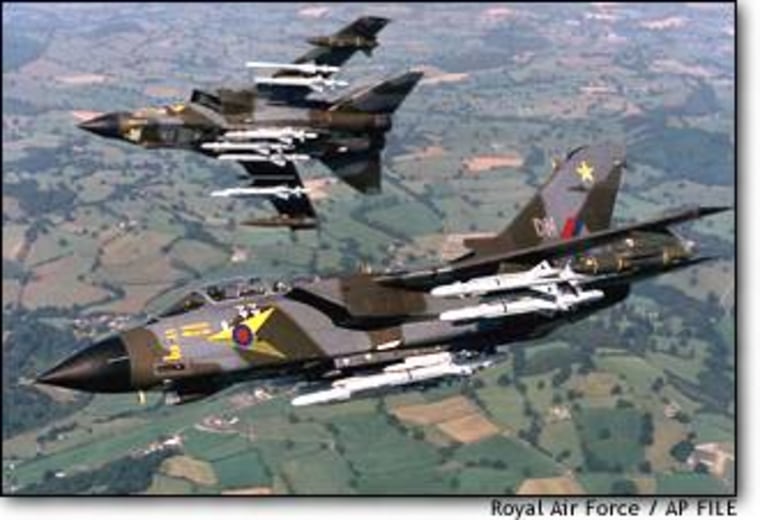The loss of a British warplane Sunday to American “friendly fire” — a Patriot missile battery near the Iraq-Kuwait border — may seem shocking. Yet, sad as it may seem, such fratricide is highly common in modern warfare, and the British pilots, tank crews and soldiers rubbing up against the mammoth American military machine know that better than anyone.
BRITISH OFFICIALS confirmed Sunday that a Patriot missile battery downed the Royal Air Force Tornado ground attack plane.
The Tornado GR4, based in Marham, Britain, was returning from an operational mission early Sunday when it was hit, according to the British press information center at U.S. Central Command
Air Force Gen. Richard Myers, chairman of the U.S. Joint Chiefs, told ABC’s “This Week” that “procedures and electronic means to identify friendly aircraft and to identify adversary aircraft ... broke down somewhere.” An official investigation has been announced.
Whatever its findings, the deaths of British troops at the hands of their American counterparts is a sad but common occurrence, just as many American troops lose their lives to their own forces. Indeed, American fire killed more British troops in the 1991 Gulf War — a total of nine — than the Iraqis did.
The statistics often stun those unfamiliar with the realities of warfare. In addition to the nine British deaths, friendly fire by American forces killed nearly one-quarter of all the U.S. troops who died in that war. Thirty-five of the 146 Americans killed in action in the Gulf War were killed by their own comrades.
The truth is, military officers regard the figure as relatively low.
“You have to put the number of friendly casualties in context,” says Jack Jacobs, a retired Army colonel who received the Medal of Honor during the Vietnam War. “Anything larger than zero is a lot. But with so few casualties overall, the friendly fire number seems large. The reality is, it is a lot lower than it would have been for a similar operation in Vietnam or World War II.”
PATRIOTS ON STEROIDS
“Friendly fire,” or “blue-on-blue” as it is known to soldiers worldwide, drew attention recently after the accidental bombing last April of a Canadian unit by an American F-16 in Afghanistan. Four of those soldiers died, and another eight were wounded — leading to Canadian demands that the pilots face court martial. This past Wednesday, a U.S. military adviser recommended against a court martial, leading to a new surge of anger from Canadians.
No one pretended ahead of the Iraq war that friendly fire incidents could be avoided. The fact that the incident appears to have involved a Patriot missile battery may raise eyebrows, however. Technically speaking, Patriot batteries are not designed to shoot down aircraft, and its radar should be able to distinguish between an aircraft moving at Mach 1 and a missile hurtling toward allied lines at Mach 3 or more.
Several factors may play into this. One are the many modifications made to the Patriots since the Gulf War, when they performed abysmally. The missiles — Patriot PAC-3s — are faster and more deadly now. Are they too deadly for the safety of the aircraft flying within their range? This is a question that is bound to be asked by post-war assessments.
The fact that Saddam Hussein’s arsenal included warplanes modified as drones and capable of spraying chemical weapons may also be a factor. Did the Patriot crew mistake the British jet for such a drone?
PROGRESS MADE
For ground forces, who generally run a higher risk of friendly fire casualties, things have improved since the first Gulf War. For American troops, one clear advantage today, according to Bill Martel, a professor at the Naval War College in Newport, R.I., is that American forces now have Global Positioning Satellite devices — GPS for short — which should make their locations more “knowable” to their comrades.
Since 1991, new “battlefield coordination detachments” have been added to the Combined Air Operations Center in hopes that such incidents would be minimized.
None of these systems is flawless. During the Afghan campaign, for instance, a special forces soldier traveling with newly invested Afghan leader Hamid Karzai gave his own GPS coordinates to a B-52 crew rather than the coordinates of the target. The results were tragic, and Karzai very nearly became a victim, too.
“I don’t think there’s any technological silver bullet that will make friendly fire events go away,” Martel says. “How do you employ tens if not hundreds of thousands of people in combat and eliminate human error? You can’t. How can you prevent someone from entering the wrong GPS coordinates? You can’t.”
ALLIED CONCERNS
Friendly fire incidents always bear an extra level of angst when they occur between forces of different nationalities. British officers were particularly concerned that their military had not taken the right steps to protect themselves. GPS is not standard equipment for British units — a fact that caused an uproar when it became clear that British troops would join another Iraq war.
Lt. Colonel Andrew Larpent, who commanded the British unit that lost nine soldiers to American fire in the last war, said the dangers involved for British troops might even be greater this time around.
“Why is it that our soldiers again will have nothing better to protect them than some very rudimentary system that we used without success back then?” he asked in a letter to a British newspaper in December.
